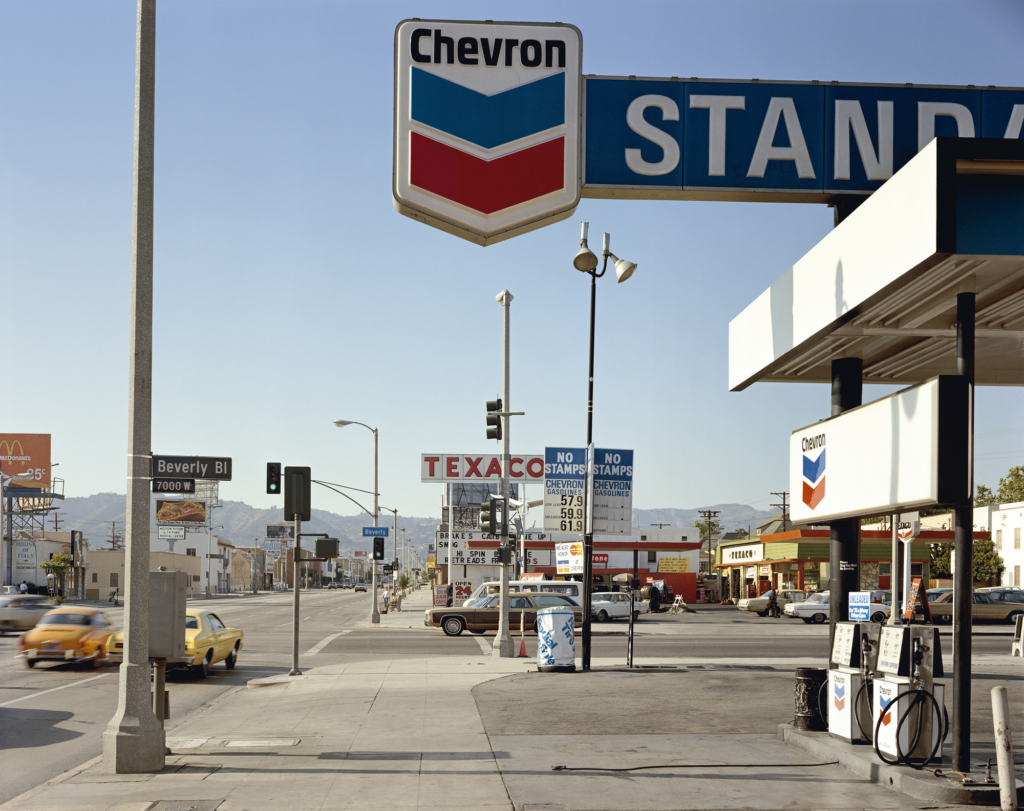CASE STUDY: Stephen Shore, Beverly Boulevard and La Brea Avenue, Los Angeles, California, June 21, 1975, chromogenic colour print

Technical Analysis
Lighting: The image is illuminated by natural daylight, casting strong shadows and enhancing contrast. The even lighting ensures all elements remain visible and well-defined. The bright, clear sky provides a solid backdrop for the man-made structures in the foreground.
Aperture: The deep depth of field keeps every element sharp, from the Chevron sign in the foreground to the mountains in the distance.
Shutter Speed: The presence of motion blur in the orange and yellow cars in the foreground suggests a slightly slower shutter speed, emphasizing movement in contrast to the stillness of the signage and architecture.
ISO: The fine grain and sharp detail indicate a low ISO, maintaining clarity in both bright and shadow areas.
White Balance: The cool blue sky contrasts with the warmer tones of the signage and pavement, reinforcing the separation between natural and man-made elements.
Visual Analysis
The foreground is heavily cluttered with signs, traffic lights, and fuel station, while the background is an open, expansive sky with distant mountains. This juxtaposition emphasizes how even though urbanization occurred , natural landscapes are always in part present and not forever lost, however very much dominated and overwhelmed by the man-made structures
Colour:
The dominant red, white, and blue in the Chevron sign echo American nationalism, reinforcing the idea that corporate branding is deeply embedded in American identity.
Tone:
The photograph balances light and dark tones, using contrast to define structures. The solid blue sky acts as negative space, making the signs stand out prominently.
Texture:
The smooth, reflective surfaces of signs and vehicles contrast with the rough pavement
Shape & Form:
The strong geometric composition features rectangles, vertical lines, and directional signage, creating leading lines which help your eyes through the image.
Pattern & Repetition:
The repetition of corporate signage (Chevron, Texaco) and road signs emphasizes the omnipresence of consumer culture.
Line & Space:
The road acts as a leading line, guiding the viewer’s eye toward the mountains.
The Chevron sign’s arrows direct the gaze further into the scene
The low horizon line places emphasis on the sky while anchoring the cluttered urban environment below.
Contextual Analysis
Historical Context:
The low fuel prices indicate a time when gasoline was significantly cheaper, reflecting an era of car dependency.
The 1970s American Dream was heavily associated with freedom, travel, and consumerism, all fuelled by the oil industry.
Personal Context
Stephen Shore, a key figure in the New Topographics movement, deliberately photographed mundane, everyday American scenes to challenge traditional ideas of beauty in photography.
Cultural/Social/Political Contexts:
The signage pollution symbolizes corporate intrusion into public spaces.
The American car culture and oil industry are central themes fuel companies profited from the nation’s reliance on cars , influencing infrastructure and lifestyle choices.
Wider Connections:
The tension between national pride (symbolized by American colors) and corporate dominance raises questions about whether commercialism has overtaken cultural identity.
Conceptual Analysis
The Chevron sign is a dominant signifier, larger and more prominent than any natural elements in the frame, symbolizing corporate power.
The use of red, white, and blue in the Chevron sign mirrors the American flag, blending corporate branding with national identity.
The large-format camera allows for a vast depth of field, ensuring every detail is crisp and visible. This enhances the documentary nature of the image, making the viewer engage with all elements rather than focusing on a singular subject.
